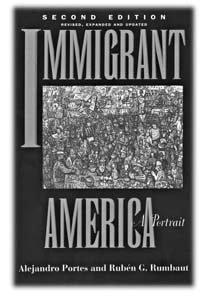![[Metroactive Books]](/books/gifs/books468.gif)
![[Metroactive Books]](/books/gifs/books468.gif)
[ Books Index | Metro | Metroactive Central | Archives ]
Undoing Many Myths
By Michael Learmonth
SILICON VALLEY high-tech firms, still giddy over their newfound political clout, have weighed in heavily on the immigration issue. They need immigrant workers, they say, not as cheap labor on the assembly lines but as engineers in the laboratories and executives in the board rooms. Announcing that immigration is "especially vital to Silicon Valley," Congressman Tom Campbell recently joined other local politicians in demanding that the San Jose Immigration and Naturalization Service office be expanded to reduce the processing time of immigration requests from a year to three months.
But if Silicon Valley's captains of industry are to convince Congress and the public of the merits of legal immigration, they are going to have to cut through some of the myths that drive very powerful anti-immigrant sentiment.
The authors of Immigrant America are also trying to bring facts to a debate thus far driven by rhetoric and raw emotions on both sides of the issue. Sociologists Alejandro Portes and Rubén G. Rumbaut first published their book, a historic description of immigration bolstered by demographic and sociological studies, in 1990. The second edition, (UC-Press) is updated to include more recent studies and an interpretation of Proposition 187, which Portes and Rumbaut say marks the second period of extreme nativist backlash in this century.
The book opens with a series of composite sketches of the lives of recent immigrants--a Mexican mechanic, a Vietnamese computer manufacturer, a Cuban architect and an Indian med-school professor. From the start, the authors set out to dispel the immigrant-on-welfare stereotype. Then, armed with 35 tables of figures, the authors lay waste to some popular immigration myths with an almost palpable glee:
Myth #1: Immigrants are less skilled and educated than the native-born.
Actually, in 1990, the proportion of immigrants with a college education was the same as that of the native-born population. In 1993, the percentage of immigrants classified by the INS as "professionals" or "managers" was much higher than for the U.S. population as a whole.
Myth #2: Immigrants today (Asians, Hispanics, Africans) are poorer quality than immigrants of the past (west Europeans).
Wrong and racist. Today's immigrants are better educated and more skilled than were those arriving at any time in the past. The same was said about southern Europeans and Japanese at the turn of the century.
Myth #3: Immigrants resist learning English.
The authors note that the most powerful "litmus test of Americanization" is nonaccented English. Language acquisition in the U.S.--as compared with aquisition in other nations with linguistic diversity, such as Canada, Ireland, Nigeria--is relatively swift and usually results in the death of immigrant tongues in just a few generations.
Myth #4: Immigrants take away jobs.
A study of southwestern cities found that a 10 percent increase in illegal immigration from Mexico actually boosted white male wages by 0.4 percent and Mexican-American wages by 0.12 percent. White unemployment simultaneously decreased as immigrant labor helped sustain the pace of economic growth and revived flagging industries such as manufacturing.
Myth #5: Immigrant bashing is new.
For perspective, the authors compare recent immigration politics with turn-of-the-century nativism that resulted in the passage of the National Origins Act of 1924, sharply restricting immigration from southern Europe and Japan.
Edward Jarvis' 1855 study of asylums in Boston found that immigrants accounted for a notably large proportion of "lunatics" in Massachusetts. Jarvis concluded that the state was spending "millions of dollars annually for the care and maintenance of an alien population which should have been excluded by the federal government." Sound familiar?
At that time, Social Darwinists were trying to explain why some immigrant groups seem to succeed in the U.S. at greater rates than others. On this point, Portes and Rumbaut give a sharp kick to Max Weber, whose theory of the Protestant ethic and the development of capitalism may be the greatest American immigration myth of all. The authors show that rather than culture or genes, immigrant success has far more to do with educational levels, the reasons for emigrating and the nature of the community in America that receives them.
An extensive online bibliography of books and
THE AUTHORS successfully argue that immigration was crucial during periods of economic expansion in the U.S. But while looking at historical patterns is comforting to the pro-immigration point of view, Immigrant America takes the tactic to a simplistic extreme and fail to ask critical questions.
Should the U.S. tighten control of its borders as it pushes against the limits of growth and resources? How much immigration is beneficial to American society? Simply pointing to the happy results of past periods of immigration won't make these questions go away.
Naturally, the book's numbers are heavily tilted toward legal immigrants. To the consternation of immigration alarmists, illegal immigration is virtually impossible to measure, except in the most general terms. And what alarmists don't know will scare them. Especially those infrared videotapes of illegals scaling fences and running from border patrol guards.
On the whole, Immigrant America succeeds in showing that the immigration issue has more facets than either side knows or is willing to admit. The authors are to be admired for bringing scholarship and intelligence to a critical national discussion dumbed down by empty slogans and stump speeches.
[ Metro | Metroactive Central | Archives ]
This page was designed and created by the Boulevards team.

'Immigrant America' refutes some of the misconceptions of assimilation and success
![[line]](/gifs/line.gif)
articles about immigration issues.![[line]](/gifs/line.gif)
From the March 13-19, 1997 issue of Metro
Copyright © 1997 Metro Publishing, Inc.